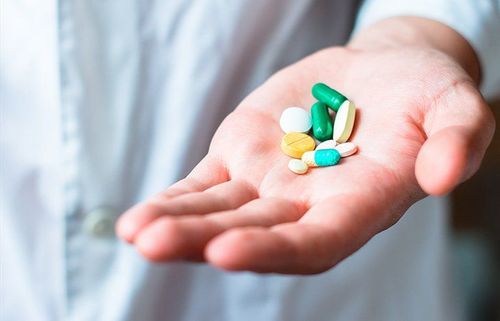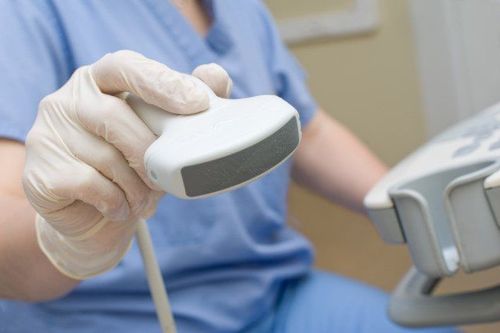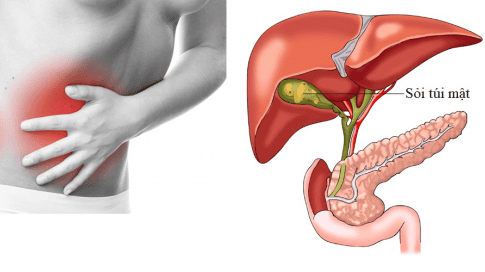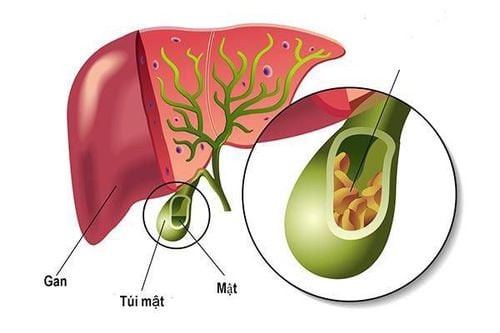This is an automatically translated article.
The article is professionally consulted by Master. Doctor II Phan Thi Minh Huong - Gastroenterologist - Department of Medical Examination & Internal Medicine - Vinmec Danang International General Hospital.Gallstones are a pathology discovered incidentally during abdominal ultrasound or when right-sided colic pain requires hospitalization. In any case, the diagnosis makes the patient bewildered and worried. Therefore, understanding about this pathology is necessary for timely prevention or treatment to limit dangerous complications.
1. What are gallstones?
The gallbladder is a component of the bile duct system outside the liver. The main function of the gallbladder is to store and concentrate bile before it is secreted into the small intestine, participating in the digestion of food. Therefore, the gallbladder is also a very easy place to form stones, causing gallstone disease.Depending on the size, number of stones and their location, patients will have different symptoms. However, once there is a place to form stones, the patient can have both gallstones on the biliary system in general, gallstones in particular, even stones in the gallbladder lumen, and stones. Gallbladder neck obstruction, cystic duct.
In women, middle age, especially obese, having many children, gallstones are quite common. Sometimes the disease is only discovered by chance on abdominal ultrasound, but sometimes it causes severe abdominal pain due to being stuck in a narrow place, which can be life-threatening if not promptly intervened.
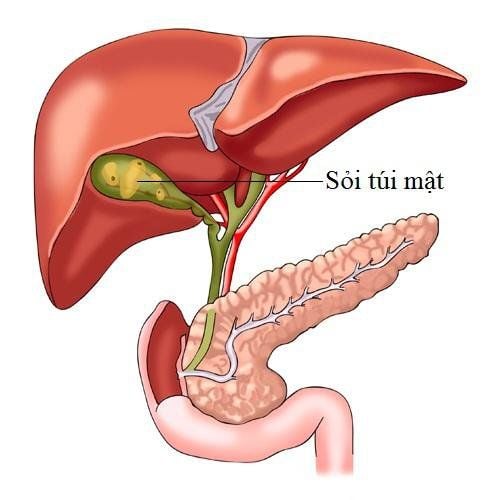
Túi mật cũng là nơi rất dễ hình thành sỏi
2. How are gallstones formed?
Bile is the product of many substances metabolized and produced by the liver parenchyma. Accordingly, there are many causes of gallstones, the most prominent being an imbalance between the components of bile. However, gallstones are classified into 3 main types based on the main composition of the stones, including: cholesterol stones, pigment stones and mixed stones. In particular, pigment stones include 2 types: black stones and brown stones. Each type of stone has a different formation mechanism.2.1. Cholesterol stones Cholesterol is a water-insoluble component. To be soluble, cholesterol is further combined with bile salts and lecithin. Therefore, when there is an imbalance in concentration between these three components, the cholesterol concentration will be much higher, so it is easy to crystallize to form cholesterol crystals and then to form cholesterol stones.
The most common imbalance is caused by elevated cholesterol levels. This is a consequence of a diet too high in cholesterol, liver disease that lacks enzymes, cannot metabolize lipids, so it causes stagnation, due to dyslipidemia or risk factors for dyslipidemia in general. Therefore, cholesterol gallstones are common in developed countries and Western countries when the diet is rich in fat and fat. In Vietnam or Asian countries, the rate of this type of stone is less.
In the case of normal cholesterol, the amount of bile salts and lecithin is reduced due to increased absorption or inflammation of the biliary tract, not combining all the cholesterol, causing stagnation, also forming stones.
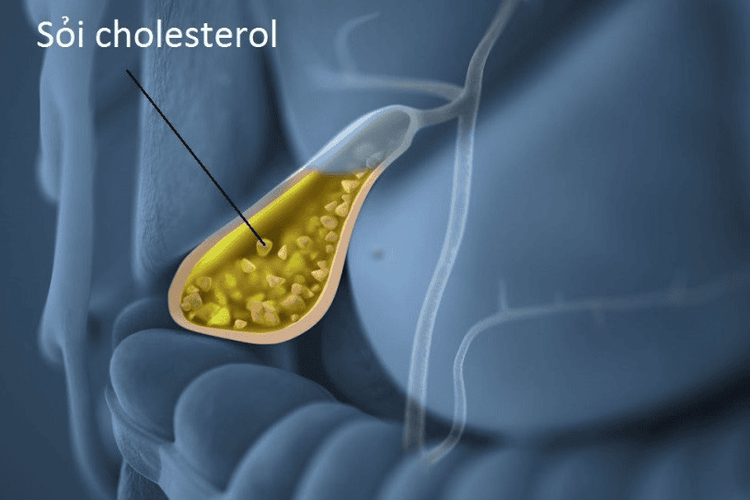
Sỏi túi mật Cholesterol
In addition, the solubility of calcium in bile is also reduced, the gallbladder epithelium increases bile acid production and thereby increases the amount of calcium carbonate. The reduced function of the gallbladder epithelial layer will cause the gallbladder to contract less, increasing the risk of stone formation.
2.3. Brown pigment stones The mechanism of brown stone formation is based on the obstruction of the bile ducts combined with the presence of bacteria, usually E. coli, Enterococcus, parasites such as roundworms or liver flukes that produce bilirubin metabolizing enzymes. from the conjugated form to the free form, which combines with calcium in the gallbladder to form calcium bilirubinate which precipitates into brown stones.
This is a common stone in many Asian countries as well as Vietnam.
2.4. Mixed stones Mixed stones do not specify any components that make up stones, but have a mechanism of formation due to causes of stagnation of bile circulation, deposition and stone formation, especially those with a low lifestyle. active, sitting a lot,...
On the other hand, the absolute fat diet makes the need for bile secretion minimized, the gallbladder reduces movement, less contractions to expel bile, so it is easy to create stones. In addition, the use of antispasmodics of smooth muscle also affects the gallbladder, promoting stone formation...
3. Are gallstones dangerous?
Gallstones are inherently completely benign if they do not cause any symptoms on their own. In some cases, it presents with the typical symptom of biliary colic. The pain has a repetitive nature, similar in characteristics, location, direction, and time and duration of the attack, causing the patient to have "experience". At the same time, the patient may have nausea and vomiting, bloating, indigestion, especially with fatty foods.The mechanism of biliary colic is due to gallbladder contraction to excrete bile with each meal; afterward; The gallbladder reduces contractions, so the pain is relieved. However, if the stone is stuck in the neck of the gallbladder or falls into the cystic duct, acute cholecystitis will occur. At this time, the indications for emergency surgery need to be set out quickly; if delayed, it can cause biliary tract infection, septic shock and bacteremia, life-threatening.
In case the gallstone falls out of the gallbladder and gets stuck in the end of the common bile duct, it will block the pancreatic duct. Pancreatic enzymes are produced but not secreted, causing acute pancreatitis. At that time, the patient will have severe abdominal cramps and vomiting, easy to drop blood pressure, respiratory failure, kidney failure and critical on many organs.
A few will lead to gallbladder cancer due to chronic inflammatory provoking conditions. The risk is increased if there are large, many gallstones, stones accompanied by gallbladder polyps, porcelain gallbladder. The disease often progresses silently, the symptoms are poor, so it is often detected at a too late stage.
4. How to treat gallstones?
Today, when abdominal ultrasound has become too common, gallstones are detected quite early and many cases are intervened even when there are no symptoms. However, the most appropriate indication is to intervene only when there are symptoms or in situations of large stones, many stones or patients at high risk of developing cancer.To treat gallstones from the time there are no symptoms can use drugs to dissolve stones. However, the effectiveness of these drugs has not been fully agreed. At the same time, gallstones can be removed by stone removal procedures through upper gastrointestinal endoscopy, percutaneous tunneling or extracorporeal lithotripsy. Because these methods only minimally invasive, because the gallbladder is still left, it is not guaranteed that the stone will not form again.
The current method of completely eliminating gallstones is laparoscopic cholecystectomy. Because laparoscopic surgery has many obvious advantages over open surgery, it tends to be more popular with small incisions, high aesthetics, fast patient recovery, and short hospital stay. After that, because the liver is the only organ that produces bile, the supply of bile for digestive needs is still guaranteed without fear of any shortage.
However, because it is not stored in the gallbladder but is excreted continuously, the bile is no longer concentrated, so when eating fat, the patient will have a feeling of slow digestion, bloating and fat stools. This is a common phenomenon and will disappear if the patient only eats protein, carbohydrates and completely abstains from fat. Therefore, after cholecystectomy, patients should limit eating a lot of fat and egg yolks to help the digestive system adapt slowly.
To help protect customers' health in a comprehensive way, Vinmec International General Hospital has launched Hepatobiliary Screening Packages with different levels of intensive screening, depending on the specific needs of the patient. Patients, help customers evaluate liver function, comprehensive bile, perform tests to help detect liver and biliary problems at the earliest, from which the doctor will give appropriate treatment advice.
Screening results are guaranteed to have the highest accuracy when performed by a team of highly qualified and experienced medical doctors; modern and advanced technological equipment; Professional quality service, methodical.
Please dial HOTLINE for more information or register for an appointment HERE. Download MyVinmec app to make appointments faster and to manage your bookings easily.





